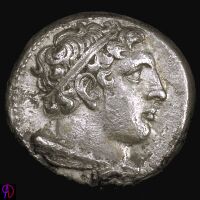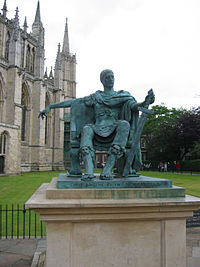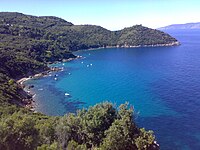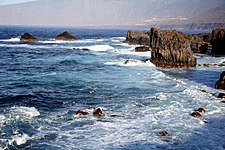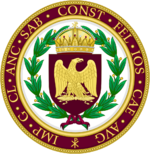Latium: Difference between revisions
m (→Military) |
|||
| Line 224: | Line 224: | ||
{{main|Latin Armed Forces|Praetorian Guard of Latium{{!}}Praetorian Guard|Scholarian Guard}} | {{main|Latin Armed Forces|Praetorian Guard of Latium{{!}}Praetorian Guard|Scholarian Guard}} | ||
[[File:French Republican Guard Bastille Day 2007 n2.jpg|200px|right|thumb|Members of the Praetorian Guard.]] | [[File:French Republican Guard Bastille Day 2007 n2.jpg|200px|right|thumb|Members of the Praetorian Guard.]] | ||
The Latin [[Latin Army|Army]], [[Navy | The Latin [[Latin Army|Army]], [[Latin Navy|Navy]], Air Force, [[Scholarian Guard]] and the [[Praetorian Guard of Latium|Praetorian Guard]] – a quasi branch of the military – collectively form the [[Latin Armed Forces]], under the command of the Monarch as commander-in-chief. Military service is entirely voluntary and has been since 1988. In 2016, the Latin military had 340,377 personnel on active duty. There are also nearly 100,000 members of the Civil Guard, who act as a national gendarmerie. There is no estimate as to whether Latium has access to nuclear weapons. Latium's chief international intelligence agency is the [[Security and Intelligence Agency of Latium|SAI]]; while it's chief domestic intelligence agency is the [[Frumentarii]]. Both are officially a branch of the Praetorian Guard, though in the modern era each is nearly independent of the Guard. Total defense spending amounts to 2.94% of national GDP. | ||
===Elections=== | ===Elections=== | ||
There are five types of elections in Latium: national general elections, elections to devolved parliaments and assemblies, elections to the county commissions, local elections, and mayoral elections. Elections are held on Election Day, which is conventionally a Tuesday or Thursday. General elections, in the past, did not have fixed dates, with a necessity for them to be called within five years of the opening of senate following the last election, before the passing of the Fixed-term Senate Act 2011. Since the Fixed-term Act, election dates are set for every five years but leaves the option for the emperor to call for snap elections in the event a government collapses or another extra-ordinary event occurs. Other elections are held on fixed dates, though in the case of the devolved assemblies and legislatures early elections can occur in certain situations. Currently, three electoral systems are used: the single member plurality system (first past the post), the single transferable vote, and the supplementary vote. | There are five types of elections in Latium: national general elections, elections to devolved parliaments and assemblies, elections to the county commissions, local elections, and mayoral elections. Elections are held on Election Day, which is conventionally a Tuesday or Thursday. General elections, in the past, did not have fixed dates, with a necessity for them to be called within five years of the opening of senate following the last election, before the passing of the Fixed-term Senate Act 2011. Since the Fixed-term Act, election dates are set for every five years but leaves the option for the emperor to call for snap elections in the event a government collapses or another extra-ordinary event occurs. Other elections are held on fixed dates, though in the case of the devolved assemblies and legislatures early elections can occur in certain situations. Currently, three electoral systems are used: the single member plurality system (first past the post), the single transferable vote, and the supplementary vote. | ||
Revision as of 19:19, 22 January 2019
Latin Empire Imperium Latinum (Latin) | |
|---|---|
| Motto: In hoc signo vinces ("In this sign you will conquer") | |
| Anthem: Imperialis hymnus Imperial Hymn | |
 Location of Latium (dark green) – in Belisaria (dark grey) – in the Belisarian Community (light green) | |
 Political Map of Latium | |
| Capital and largest city | Castellum ab Alba |
| Official language and national language | Latin |
| Recognized regional languages | |
| Ethnic groups (2014) |
|
| Religion | State religion: Fabrian Catholic Other recognized: Protestantism (Reformed, Episcopalian, Union Reformed) Alban Christian, Judaism, Irreligion |
| Demonym(s) | Latin |
| Government | Unitary parliamentary executive monarchy |
• Emperor | Constantine XX |
• Consul | Alexander Pompilius |
| The Duke of Ossonoba | |
| Legislature | Senate |
| Formation | |
• Founding of Castellum | 821 BC |
• Latin Kingdom | 290 BC |
• Proclamation of Empire | 3 August 127 AD |
| 19 November 1866 | |
• Acts of Constitutional Reform | 9 June 1954 |
• Formation of the Belisarian Community | 18 March 1959 |
| Area | |
• | 584,850 km2 (225,810 sq mi) (nth) |
| Population | |
• 2018 estimate | 87,216,912 |
• 2017 census | 86,832,912 |
• Density | 117.69/km2 (304.8/sq mi) |
| GDP (PPP) | 2018 estimate |
• Total | $4.021 trillion |
• Per capita | $46,109 |
| GDP (nominal) | 2018 estimate |
• Total | $3.971 trillion |
• Per capita | $45,539 |
| HDI | 0.873 very high |
| Currency | Solidus ($) (LAS) |
| Date format | dd/mm/yyyy (AD) |
| Driving side | left |
| Calling code | +4 |
| ISO 3166 code | LA |
| Internet TLD | .la |
Latium, also know as the Latin Empire (Imperium Latinum) or less commonly as the Empire of the Latins, is a unitary constitutional monarchy, where the monarch exercises executive power, located in Belisaria sharing open land borders with the Ecclesiastical State, Lyncanestria, Lihnidos, and a maritime border with Arthurista. It is located in southwestern Belisaria, bordering the Angusta Strait to the west, Periclean Ocean to the east and south, and the Thalassan Ocean to the southwest, placing Latium at a key crossroads of international trade. With over 87 million inhabitants, it is the largest member of the Belisarian Community.
Since the classical period, ancient Aradians, and Hellenes established settlements in southern and eastern Latium respectively, with Latinic tribes spread throughout the rest of the peninsula. A Latinic tribe known as the Albans would found the Alban Kingdom, later merging with another Latinic tribe centered around Castellum to for the Latin Kingdom. Eventually, the Latin Empire expanded to encompass nearly the entirety of the Periclean coast, including the modern-day territories of Audonia, Eagleland, and coastal northern Scipia, resulting in it emerging as a dominant cultural, political, and religious center.
During the middle ages, the ancient Latin Empire collapsed, resulting in widespread turmoil in Latium, but the Latin Crown persisted, living on in Alexandria, and by the 12 century growing to be recognized as the main successor to the Latin Empire, over its chief rival in Adrianople. These two competing crowns often battled one another, at times clashing to the Audonic-states of the Holy Audonian Empire to the north. By the 14th century, Latins had expanded once again, this time across the Thalassan Ocean, establishing colonies in Norumbia, modern-day Belfras. The 14th through 18th centuries saw Latium expand towards its modern-day borders, after clashes with Audonic neighbors in modern-day Lyncanestria and Lihnidos. By the 19th century, Latium experienced rapid industrialization, and despite its economic and geopolitical gains, suffered the rise of fascism in the 1930s, ultimately resulting in the Social War in 1945. Following the conclusion of the war in 1947, Latium experienced an economic boom and the introduction of democratic reforms and the creation of the Belisarian Community.
Today, Latium has the Xth largest economy in the world. As an advanced economy the country is home to high human development and life expectancy. The country plays a major role in regional and global economic, military, cultural, political, and diplomatic affairs. It is a founding and leading member of the Belisarian Community, the Forum of Nations and the Organization of Latin States, as well as a participating member of the Joint Space Agency.
Etymology
The first mentions of the name Latium was first arise from the initial unification of the various Latin tribes in the area of Castellum, which was occasionally referred to as Alba. The term Latium, originally, only referred to this area near the Eridanus River, though later expanded to be used as a term for the entirety of Latin controlled territory from the 5th century onward. Latium is believed to have been derived from the word "latus", meaning "wide" or "flat land". Similarly, the demonym "Latin", and the Latin tribes of the region, are believed to mean "men of the plain".
History
Latin culture traditionally traces its roots back to ancient Latinic tribes of southwestern Belisaria. Historically, the area had been inhabited by a variety of different tribal groups, from minor Celtic tribes in the northwest and coastal regions, minor Rhegedi tribes along the eastern coasts, and Latin tribes spread throughout the rest of Latium. Greek cities had originally been founded as early as 911 BC in modern day Imbros, on the western coast of Latium. Modern Latins primarily descend from the ancient city of Castellum and its surrounding area consist of Latium's major ethnic group; however, Hellenes remain a sizable minority and make up nearly 4% of the population.
The ancient peoples of Latium – such as the Pelasgians, Aimones, Aeolians, the Eleni and the Rasinai which inhabited northern modern Latium, and many others – were other proto-Latinic peoples; the main historic peoples of proto-Latinic heritage include the Latinii and Iolei.
Between the 15th and the 11th century BC Greeks traders established contacts with the many non-Hellenic early ancient peoples and in the 10th and 9th centuries BC, Greek colonies were established all along the coasts of modern day Latium, eventually making inroads into the interior. These Greek settlers would first come into contact with Castellum near the 9th century BC, which at the time was a small agricultural community. However, recent excavations outside of modern day Alexandria create a theory that there were far more ancient cities that were much older than ancient Castellum.
Classical era
Castellum ab Alba, founded near the mouth of the Frusina River, was conventionally founded in the 9th century BC, and was ruled by a dynasty of kings from its founding until the 4th century BC, when it incorporated a form of oligarchic rule, while the role of king was slowly diminished. Tradition claims that the city was founded by Apollp, and that all kings were descended from him. Around the 6th century BC, Latins inhabiting Castellum often clashed with neighboring settlements, most commonly Alba and Heliopolis – a major Hellene settlement at the time. By the 3rd century BC, Castellum incorporated much of eastern Latium. During the reign of Gaius Caesar in near the end of the 2rd century, the monarchy regained many of its prerogatives, and saw a decline in the oligarchic system in the Senate.
Over the course of its history, Castellum and its surrounding area was often referred to as Latium, from which the empire and modern nation take its name. By the 1st century, the Latin people of Castellum and Alba proclaimed King Valentinian to be "Imperator Latini" (Latin Emperor or more archaically, Latin commander), to denote his role as the leader of all Latin tribes, peoples, and cities, as well as Castellum and Alba's dominion over much of what is now eastern and central Latium, while reaching as far south as Utica, where it constantly entered hostilities with Aradian settlements.
Imperial era
The Caesarian dynasty ruled over the fledging Latin Empire, and throughout this period, the Latin Empire, which was increasingly called Latium or Latia, faced repeated attacks from the remaining Aradian city-states that held out on the southern coast near Boroea and Orola. The Aradian city-states would persist until the 2nd century BC when the Aradians were finally pushed off of Belisaria and only retained their Scipian holdings; however, those too would eventually fall to Latium at the invasion of Master of Offices Felix Claudius, who finally ended the long and storied history of the once mightly Aradian civilization, reducing it to a backwater Imperial province in 101 BC.
The entrance into Scipia via the wars with Aradia served as a springboard for future conquests of coastal Akhad and Eagleland, which was incorporated into the Latin Empire in AD 587. While the Empire grew overseas, the Latins faced considerable difficulty in conquering the Celtic tribes and kingdoms of the northwest near the modern Lyncanestrian border. It wasn't until the early 8th century that these Celtic tribes would be conquered. At its height, the Latin Empire controlled lands throughout Audonia, reached as far north as the borders of XXXX, and as far east as Ahkad in Scipia.
The early Imperial era was marked by continued grown of the aforementioned conquests of neighboring communities and non-Latin kingdoms or cities. However, the era was marked with tremendous cultural and religious upheaval. In this time, from the 1st century AD until the 4th century, Latium had been dominated by the pagan cults of Apollo as the god of light, fire and life and his chief adversary Februus as the god of darkness and death. The Christian faith was first introduced during the late 1st century AD. Initially, the faith was limited to small folk and lowborn subjects of the empire. Members of the faith were sporadically persecuted by the Latin emperors, and often blamed for poor harvests, and other catastrophes. The worst such event was following the fire of Castellum which consumed nearly half of the city, when Emperor Valentinian II ordered the christian population of the city to be killed. While some were able to flee and escape death, many were executed.
The faith spread quickly among the masses, and later gained Imperial support from the Emperor Alexander I during his youth. Emperor Alexander's conversion was prompted by a a vision one night and was told that "in Jesus' name [he] will conquer" and that Latium would truly fulfill its destiny. Alexander was expelled from the Imperial family when his father, Emperor Leo II, heard news of the conversion and Alexander's marriage to an Alban Christian. Christianity would later become accepted by the Edict of Ravenna, after Alexander's successful war for the throne. it later became the official state faith in 320. The state sponsored faith remained Alban Christianity until the conversion of Emperor Constantine IV, who accepted the primacy of the Bishop of Fabria, and Fabrian Catholicism in AD 540. Template:Politics of the Latin Empire
Middle Ages: Muslim invasion and Recuperatio
Colonial empire
Modern Age: Reform and Social War
Contemporary history
Geography
Latium is located on the continent of Belisaria. To the north, Latium borders Lyncanestria, and Lihnidos, and Fabria-Poveglia to the east. To the west, Latium shares a maritime border with Arthurista. It is located at the southern tip of Belisaria, and holds a key location at the strait between Belisaria and Scipia, where the Thalassan Ocean meets the Perliclean Sea. Nearly half of Latium consists of mountains or hills, with mountains being located in the Hellenic counties of the east, near the Lyncanestrian border. Although the country's core is located primarily on continental Belisaria, Latium controls a number of islands off its coast, including the Periclean island of Imbros to its east, and the Aveli Islands located X miles off the coast of Sydalon in the Thalassan Ocean.
Biodiversity
Latium has a high level of biodiversity due to its location between the Periclean and the Thalassan and between Belisaria and Scipia. Latin fauna includes some 3000 species, including Latin wolves, Gelonian red deer, Appennina brown bear, Aradan seal, a number of frogs and other amphibians, etc. Flora of Latium matches that of other nations located in the Periclean climate regions, and has nearly 6,000 types of plant species.
Climate
The coastal areas along most of the south generally fit the Mediterranean climate stereotype (Köppen climate classification Csa). Conditions on north coast, along the Tempesta areas can be very different from the interior's higher ground and valleys, particularly during the winter months when the higher altitudes tend to be cold, wet, and often snowy. The coastal regions have mild winters and warm and generally dry summers, although lowland valleys can be quite hot in summer. Interior areas largely consist of climates ranging from humid subtropical to humid continental. However, summers are typically hot and dry, with more mild and wet throughout Latium.
Landscape of central Latium near Cularo
Vineyards located in western Latium near Adrianople
Politics
The modern Latin state traces its legitimacy to the ancient Latin Empire and first emperors of Latium. Many of Latium's current government structures derive from the ancient constructs, though have been reformed on occasion throughout history, most recently by Diana Augusta following the Social War.
Latium is a unitary state, where the central mperial government is supreme and the many administrative divisions are given only the limited powers delegated to them by the central government. The degree of devolved powers given to a county or unitary authority are largely allotted on a case-by-case basis, which are subject to Senate legislation that generally require renewal after any number of years.
Monarch
The position of the monarch traces its beginnings to the ancient kings and later emperors of Latium. These ancient rulers initially gained their powers from their armies and later as simply being the leader of the Castellum and Alba. The emperor ruled absolutely without consultation of the early senate and only minimal interjection by Senators and the nobility, and later on the clergy.
Today The Monarchy is classified as a constitutional monarchy, though the Monarch still retains significant executive powers, allowing it to be classified as an executive monarchy. The Monarch serves as the chief executive, sharing many of the same powers as a president in a presidential system or semi-presidential system. While his position as Princeps Senatus or First man of the Senate, allows him to nominally be the chief legislator, in practice and by constitutional convention the consul serves as head of government. The Monarch holds the power to directly propose legislation and laws. Additionally, the Monarch possesses the ability to direct much of the executive Imperial Office through executive orders that are grounded on constitutionally granted executive power. Executive orders can be superseded by senate legislation, provided the Monarch assents. In rare instances, the emperor can rule purely through the use of what is called, Imperial Executive Decree or Imperial Edict, which is an executive order of a much high magnitude. These edicts may be challenged in the courts, and in most instances are drafted with Senate leadership before their proclamation, only used in the rarest of instances such as times of war or constitutional crisis.

|

|
| Constantine XX Emperor |
Alexander Pompilius Consul |
The monarch represents Latium abroad and in international relations, giving the monarch the ability to ; however, constitutional convention allows the Senate to approve of the appointment of ambassadors. The emperor is also the commander-in-chief of the armed forces, and is the only person that is able to declare war. However, any declaration of war requires Senatorial approval and the Senate may even petition the Emperor for a declaration in – these war powers primarily exist due to constitutional convention. The monarch also must provide Imperial assent in order for Acts of the Senate to be signed into law. If assent is denied, the Senate may overturn the refusal with a three-quarter super-majority vote. While in some constitutional monarchies the Crown in Parliament is nearly a rubber stamp, it is not so in Latium, where the Monarch retains substantial political authority and activity in the legislative process.
Senate
The Senate is one of the oldest organs of the Latin government, dating back to the 8th century BC as the Alban council of elders. The first recorded written records of the Senate are dated to the 6th century BC. The Monarch is the head of senate by virtue of being Princeps Senatus, literally "first man of the senate." However, following numerous reforms in both the 1860s and 1950s, the senate is the unicameral legislature of Latium. The Consul serves as the head of government due to its role as the leader of the cabinet; however, cabinet is chaired by the Monarch. The Consul serves as the Monarch's chief government minister, and presiding officer of the Senate. Historically, the Consul was not responsible to the Senate, but solely to the Monarch. Since the 20th century, the Consul is typically the leader of the largest party or group of parties in the Senate, causing the sitting consul to hold both the confidence of the Monarch and a majority of the Senate.
Today the Senate consists of 794 senators which are elected from single-member constituencies of roughly of 98,000 residents per district. Senators traditionally must live in their constituency, though this is not always the case, for example with major party leaders. The Senate holds authority over financial and budgetary matters. Legislation is enacted by the Princeps Senatus whereby the Senate and Consul may pass legislation within the legislature, but also provides the Monarch an integral role in signing, aiding in drafting and negotiating, and sometimes even proposing legislation. There are also mechanisms that allow members of the Senate to bring to the attention of the government particular issues affecting their constituents.
The Senate Building, often referred to as Curia Claudia or more irregularly, Palatium Forum, is located near the Forum in Castellum ab Alba.
Law and criminal justice
Law in Latium traces it's roots to the early royal and imperial era in Latin history. For most of it's early history, laws were a large conglomeration of Senate acts, royal and imperial edicts, as well as court rulings, until it was complied and reformed into the Corpus Juris Civilis in AD 928. While Latium utilizes an uncodified constitution, it relies heavily on statutory law in the form of the Codes of Law, which is updated annually. Laws in the Body of Law reach back thousands of years, some of which are still valid unless a newer law contradicts the more ancient law. However, most laws from before 1860 are no longer valid following the Acts of Constitutional Reform, which to modernize the government and legal system by officially codifying structure of the government. These edicts serve as a basis for the constitution of Latium.
Following the Curiate Assembly Reform Act of 1999, the court system was reformed and with it the creation of a Supreme Court. Prior to this, there were two courts of last resort: the Curiate Assembly who would hear matters relating to administration of the state and government and the Emperor and his Council of Advisors. The newly created supreme court features nine members, who are appointed by the Emperor and confirmed by two-thirds senate vote. The court handles the final matters in cases relating to civil and criminal litigation, with a recent shift to some administrative complaints. The Supreme Court holds no or limited jurisdiction over Imperial Edicts, decrees, or Executive Orders, including most Acts of the Senate
Administrative Divisions
Latium has a number of administrative divisions, each with varying levels of authority or non-authority. Though until recently, there was no uniform standard throughout the nation for administrative divisions and which held authority over another, leaving some counties and provinces often at odds. The broadest forum of division would be the Praetorian Prefecture, of which there are four:the Praetorian Prefecture of the East, Praetorian Prefecture of the West, Praetorian Prefecture of the South, Praetorian Prefecture of the North, and Praetorian Prefecture of Castellum. These divisions, while sitting as a top level division, serve little functional purpose and hold no administrative capacity other than regional grouping.
The division which has historically held the most authority would be the province level division, though this was abolished by the Local Government Reform Act of 2011. Provinces were replaced with regions, which hold no governmental capacity and serve as a geographic distinction. Since 2011, the top level administrative division could be one of two entities: county or a unitary authority. Currently, there are a total of 90 counties, which are either metropolitan and non-metropolitan, with an additional 12 unitary authorities. While no one county is equal to another, typically a county holds an appointed Lord Lieutenant or Lord Governor who serves the county on behalf of the Emperor - though often holds no power and is often honorary - while each county or authority has a regional council of no more than seven members. Prior to 2011, only cities or metropolitan areas of a population over 500,000 were given unitary authority powers; the Local Government Reform Act altered this, afforded the powers onto cities or metropolitan areas over 150,000. These unitary authorities, typically hold more powers than their non-metropolitan counterparts. These counties are usually afforded much more powers when it comes to matter of finance compared to a non-metropolitan county, which most often handles only public transportation, and safety.
Latium also has two devolved local administration in Castellum, and Imbros. Castellum, also referred to as Greater Alba, is the oldest devolved government, and serves as the devolved local government for the the metropolitan area known as Castellum and is classified as a city-region by the government. Greater Alba exists by virtue of the Castellum Local Government Act of 1974, which established the Greater Alba Council as the regional legislature. The Castellum Act also merged the city and the surrounding boroughs into a single administrative division. Currently there are thirty-six boroughs or counties along with the ancient City of Castellum and County of the Palatine. The city authority has powers over transport, policing, economic development, and fire and emergency planning along with tax collection. There have been petitions to the Senate to create a similar governmental structure for the city and metropolitan area of Adrianople, along with previous attempts to create a similar Imbrosian government. In 2017, a majority of voters in Imbrosian-speaking counties approved a measure to create an Imbrosian government.
Foreign Relations
Latium maintains diplomatic missions with nearly all nations of Ajax through embassies. Latin foreign policy is largely shaped and executed through its membership of the Belisarian Community, of which Latium is a founding member. Latium is a member of numerous other international organizations, including the Forum of Nations, and the Organization of Latin States, both of which keep their main secretariat in Castellum ab Alba and Ascanium respectively.
Military
The Latin Army, Navy, Air Force, Scholarian Guard and the Praetorian Guard – a quasi branch of the military – collectively form the Latin Armed Forces, under the command of the Monarch as commander-in-chief. Military service is entirely voluntary and has been since 1988. In 2016, the Latin military had 340,377 personnel on active duty. There are also nearly 100,000 members of the Civil Guard, who act as a national gendarmerie. There is no estimate as to whether Latium has access to nuclear weapons. Latium's chief international intelligence agency is the SAI; while it's chief domestic intelligence agency is the Frumentarii. Both are officially a branch of the Praetorian Guard, though in the modern era each is nearly independent of the Guard. Total defense spending amounts to 2.94% of national GDP.
Elections
There are five types of elections in Latium: national general elections, elections to devolved parliaments and assemblies, elections to the county commissions, local elections, and mayoral elections. Elections are held on Election Day, which is conventionally a Tuesday or Thursday. General elections, in the past, did not have fixed dates, with a necessity for them to be called within five years of the opening of senate following the last election, before the passing of the Fixed-term Senate Act 2011. Since the Fixed-term Act, election dates are set for every five years but leaves the option for the emperor to call for snap elections in the event a government collapses or another extra-ordinary event occurs. Other elections are held on fixed dates, though in the case of the devolved assemblies and legislatures early elections can occur in certain situations. Currently, three electoral systems are used: the single member plurality system (first past the post), the single transferable vote, and the supplementary vote.
Elections are administered locally: in each lower-tier local authority, the actual polling procedure is run by the appointed Imperial Electoral Commission officer or Returning Officer and the compiling and maintenance of the electoral roll by the Electoral Registration Officer. The Imperial Electoral Commission sets standards for and issues guidelines to Returning Officers and Electoral Registration Officers, but is responsible for nationwide electoral administration (such as the registration of political parties and directing the administration of national referendums). The Electoral Commission is also responsible for determining the number of constituencies that are located in each province, but allows for provinces to have a large deal of input. Constituencies for Senatorial elections generally consist of a geographic area with the population of around 98,000 people.
Economy
Latium has a capitalist mixed economy, and is regarded as a highly industrialized nation. His Majesty's Treasury, led by the Count of the Imperial Treasury is responsible for the development and execution of government economic and public finance policy. The Bank of Latium (Argentaria Latii), Latium's central bank, is responsible for issuing the nation's currency. Latium combines extensive private enterprise with substantial state enterprise and government intervention. The government retains considerable influence over key segments of infrastructure sectors, with majority ownership of railway, electricity, aircraft, nuclear power and telecommunications. However recent Conservative governments have worked to privatize or contract out such enterprises. It is regarded as a highly industrialized nation and with high levels of trade and exports. It is a highly developed country, with a high quality of life and level of Human Development Index. The country is well known for its creative and innovative business, a large and competitive agricultural sector (Latium is one of the world leaders in wine production), and for its machinery, food, design and fashion industry, with most of these industries being located along the coastal regions of the country. Latium is notable for its exports in expensive luxury items, such as high-priced cars and jewelry.
There has been a growing divide among northern and southern coastal regions, and even among the Hellenic areas of Latium. The central, interior regions of Latium are much more rural and heavily relies upon agriculture. This coastal-internal economic division continues to exist across the borders of the devolved government of Gelonia. Eastern coastal Latium is also largely a rural area, though major population centers exist in Mediolanum, Leonopolis and Alexandria to a lesser extent and is far less populous on average when compared to the rest of the country, due in part to its more mountainous regions in the north and northeast. While Adrianople remains one of the largest city in the country, it is one of the few vibrant cities of the north, with most being situated along the southern coast. The Adrianople Central Stock Exchange (ACSE) is the leading exchange in the country, followed by the Castellum-Southern Stock Exchange.
Agriculture
According to the latest agricultural census in 2012, there were 1.2 million farms in Latium, with xx million hectares (over 55% located in southwestern Latium). A vast majority of farms are private, family owned farms, averaging near x hectares. Grain fields take up xx%, olive tree orchards x%, vineyards x%, citrus orchards x%. The remainder is primarily dedicated to pastures and feed grains.
Latium is a leading producer of wine, olive oil, fruits and vegetables. The most famous Latin wines come from the county of Karchidonia in the southwest, and vineyards in the wine belt (counties of Rhenus, Caieta, Osrhoene, and Collipo) along the Periclean Sea.
Energy
Latium has historically been dependent on importing energy, whether it be through conquest or imports from neighboring nations, as it lacks any significant oil reserve of its own. However, Latium does have sizable natural gas reserves, along with a growing fracking industry, though these have been subject to strict government regulation. In recent years, legislation has been introduced that moved to make the country more energy independent. Since, subsides have been given to alternative energy sources, which currently make-up around 17% of energy produced. Most notable is the recent project in hills of the county of Altava, where one of the largest solar power arrays is being installed with the necessary infrastructure to support it. Recent government policy has been working to grow nuclear energy as well, currently consisting of 62% of all energy production in Latium.
Industry
Tourism
Infrastructure
As of 2016, the the national road network consisted of xxx,xxx km of serviceable roads in Latium, including 8,180 km of motorways such as the Raedavea National Highway system. There is an average of 601 cars per 1000 persons.
The national railway network exists in the form of the government holding company, Ferrovia Phoenix Latiii (FPL). The FPL manages the railway tracks and infrastructure, while it's subsidiary the Ferrovodunum, manages the passenger operations.
Technology
Demographics
Largest cities or towns in Latium
Imperial Ministry of Populations (IMS) estimates for 31 July 2017 | |||||||||
|---|---|---|---|---|---|---|---|---|---|
| Rank | Diocese | Pop. | Rank | Diocese | Pop. | ||||
 Castellum ab Alba  Adrianople |
1 | Castellum ab Alba | Alba | 4,936,915 | 11 | Pola | Cameria | 446,574 |  Utica  Ascanium |
| 2 | Adrianople | Aternum | 2,872,021 | 12 | Aurunca | Cameria | 432,067 | ||
| 3 | Utica | Praetutia | 1,850,726 | 13 | Ostia | Cameria | 406,830 | ||
| 4 | Ascanium | Sabinia | 1,530,058 | 14 | Arrentium | Samnium | 394,997 | ||
| 5 | Mediolanum | Picenum | 1,096,773 | 15 | Drusum | Faventia | 375,735 | ||
| 6 | Ravenna | Sabinia | 786,424 | 16 | Bonna | Volsinia | 359,712 | ||
| 7 | Caesena | Praetutia | 696,676 | 17 | Espo | Senonia | 293,518 | ||
| 8 | Antium | Aternum | 521,913 | 18 | Entella | Volsinia | 282,082 | ||
| 9 | Vindobona | Senonia | 499,093 | 19 | Aarhusium | Oenotrium | 242,224 | ||
| 10 | Beroea | Cameria | 482,283 | 20 | Mariana | Imbros | 198,211 | ||
Metropolitan cities and Urban areas
Religion
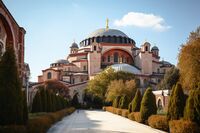
Christianity is the dominant religion in the Latium and has been the dominant faith in Latium since the mid-2nd century. Christianity first reached Latium in the late 1st century, though did not begin to grow in popularity among the lower classes until 2nd and 3rd centuries, particularly during the reign of Leo I. The most dominant christian church during this period was the Alban Apostolic Church. Christianity became the first among equals of religions in the area, though not the outright state church, during the reign of Alexander I in 337 AD. Christianity was later made the state faith during the rule of his son, Alexander II. new law did not outlaw the ancient pagan religion, but did not offer enough incentives for it to remain popular; paganism was eventually outlawed in the late 5th century.
The teachings of the Bishop of Fabria eventually overtook Alban Christianity during the reign of the first Claudii emperor, Philip I. Through active promotion and favoritism, Catholicism gradually overtook and replaced Alban Christianity. Attempts to have the churches re-enter communion have happened often, and nearly universally fail with exception of an attempt made by Emperor Jason V Augustus in the 13th century. This union did not last however, as many adherents of Alban Christianity refused to accept the union that resulted in Catholic bishops holding primacy over Alban bishops. During the reign of Empress Maria I Augusta an inquisition was held to reach religious unity in Latium. Today, Latium holds a Catholic majority, but Alban and protestant churches consist of nearly 10% of all Christians in Latium.
Freedom of religion is protected in the Acts of Constitutional Reform, thoughFabrian Catholicism remains the official state church of Latium. The Pope of the Fabrian Catholic Church is considered the spiritual leader of the Church by Latin Catholics. The highest ranking spiritual leader within Latin borders is the Archbishop of Castellum, currently held by Theodorus Afinius. The Archbishop, often referred to as Patriarch of Alba, due to the prominent role the clergy during the development of the modern Latium. The Monarch retains the right to appoint or dismiss bishops according to the Declaration on Authority and Privileges. Nearly 89% of Christians in Latium are Catholic.
Over 10% of Christians in Latium adhere to a protestant faith. The largest protestant followings in Latium are the United Reformed Communion, Vaudensian Church, the Episcopal Church of Latium, and Alban Apostolic Church.
According to the latest census, over 20% of all Latins considered themselves irreligious or adhered to no religion. This number rose 5% from the previous census. According to a private poll conducted in 2016, 7 of 10 Latins attend church or some other place of worship on a weekly basis.
Ethnic Groups
Ethnic Latins make up the majority of citizens of Latium at around 87% of the population according to the latest census. However, Latium is a very diverse nation with different ethnic groups living within its borders. The largest minority group is made up of Gelonians, at 4% of the population. The Gelonian celtic speaking population is located in northwestern Latium near the Lyncanestrian border, centered on the counties of Gelonia, Canibri and Laniobrigia, though Luetia is largely considered to be historically Gelonian.
A Hellenic population is also located in Latium, commonly referred to as Imbrosians. It is mostly located in the eastern counties of the country, mostly centered on the Imbroaisn isles off the eastern Latin coast in the Periclean Sea. The largest Imbrosian city is Aigio, though Alexandria is considered a to have a major historical Imbrosian influence.
Latin is the most commonly spoken language in Latium and the only official language of the nation. Gelonian, Imbrosian, and Rhegedian are regionally recognized languages, with Gelonian having the most native speakers, but Imbrosian having the most second language speakers. Today, nearly all citizens can speak Latin, though Gelonian and Rhegedian remain largely confined to their locales. As of 2013, an Act of the Senate required Latin be the language of schooling, though granted exemptions for schools and universities in Imbros so that Imbrosian may be used and Latin is instead a required class throughout one's educational career. In a typical Latin school, Hellene is a suggested course until year 11 in secondary school; Anglic and Audonic are also regularly taught and spoken languages among Latins that speak two or three languages.
Languages
Latin and Hellenic are the two largest languages in Latium, with Latin being the only official language of the nation. Hellenic is a regionally recognized language and is taught throughout the primary education system. Today, nearly all citizens can speak Latin, though Hellenic remains largely confined to the ethnically Greek counties and unitary authorities western Latium. Gelonian is also a regionally recognized language in the counties of Gelonia, Canibri and Laniobrigia. As of 2011, an Act of the Senate required Latin be the language of schooling, though granted exemptions for schools and universities in the more Hellenic counties so that Greek may be used and Latin is instead a required class throughout one's educational career. In a typical Latin school, Greek is a suggested course until year 11 in secondary school; English is also a highly suggested course in Latin schools.
Health
The Latin state has run a universal healthcare system under the National Health Service (Latin: Sanitas Ministerium National (SMH)) since 1978. Public healthcare is provided to all Latin permanent residents and is mostly free at the point of need, being paid for by taxation. Latium spends about 8.4% of its gross domestic product on healthcare. Private health insurance is available to those who wish to obtain different treatments. Latium has a relatively low rate of adult obesity (below 10%), probably thanks to the health benefits of the mediterranean diet.
The SMH is centrally funded through taxes and managed by a large central bureaucracy. Small responsibilities are devolved to geographical areas through Strategic Health Authorities and sometimes locally through various SMH trusts, most decision making is taken by SMH staff and the Ministers of Health and Human Services. The central government office, the Department of State for of Health and Human Services, is heavily involved in day-to-day decision making in either the Strategic Health Authorities with a degree of input from the individual local trusts. Local trusts are accountable to their local populations, whilst government ministers are accountable to Senate for the service overall.
The Latin healthcare system provides, among other things, primary care, in-patient care, long-term healthcare, psychiatric care and treatments, ophthalmology, and dentistry. All treatment is free with the exception of certain charges for prescriptions, dentistry and ophthalmology (which themselves are free to children, certain students in full-time education, the elderly, the unemployed and those on low incomes).
Prior to the creation of the SMH, citizens were required to be sponsored by a private healthcare firm. Those not covered by an employer sponsored health plan, state sponsored healthcare for those under the poverty line, or other public insurance programs (such as Latcare) to secure an approved private-insurance policy or pay a penalty, with exemptions available to those under a certain threshold of the poverty line. However, in the modern day private insurance in Latium is very rare.
Education
Education in Latium is mandatory from ages five to seventeen and consists of five stages, three of which are compulsory: nursery school (schola seminarium), primary school (schola primaria), middle school (schola medium), secondary school (schola secundaria) and university (universitas). Nursery school is the first stage of schooling, which students attend from ages 3-4; nursery school is not mandatory, though is becoming more common in recent years. Primary education occurs from ages 5 to 11; students are given a basic education in Latin, mathematics, natural sciences, history, geography, social studies, physical education and visual, musical arts, and occasionally Anglic, Audonias, or Hellenic. Middle education occurs from ages 11 to 13. Secondary education occurs from ages 13 to 17. While public, state-run education is available to all children under the age of 18, many can and do send their children to the various charter, private or religious schools. In some remote areas, these private or religious schools are sometimes contracted to admit the locale's students by the government. College education is not mandatory in Latium, though students may wish to enroll at public, private or standalone graduate universities following their accomplishment of secondary education. The largest public university in the country is the University of Aarhusium located in western Latium. The highest ranked tertiary schools are the University of Haenna, City College of Velia, University of Castellum Iohnnes XIII, University of Alexandria, Utica University and Ariminum College. Latium is also home to three service academies: Academia Militaris Olympia, Imperial Air Academy at Acrae, and Imperial Naval College at Pola.
Culture
Architecture
Literature and Theatre
Music
Sports
The most popular sport in Latium is football, with the modern game being adopted by Latins in the late 19th century. Latium's men's national football team is one of the most successful in the world, having won the UAFA Cup 7 times (1932, 1942, 1956, 1958, 1962, 1964, 2016), and finished in the top four 15 times. Olympiou Energeia Liga Premier is the top flight football league in the country and prominent on the continent of Belisaria; it governed by the Latin Association for Football. The Latin Premiership is home to 22 teams from throughout Latium and features the typical promotion and relegation with the Latin lower leagues. Liga Una is the second tier football league in Latium, and is home to 22 teams; three teams are promoted to Liga Premier and four teams are relegated to Liga Secundia at the conclusion of each season. Liga Secundia is the lowest division of the Liga system and relegates four teams to Liga Pro, which is the fourth tier in Latin football and top league of the Pro system. The Pro system consists of 24 teams in Liga Pro, relegating two teams to Liga Pro Vindiciae (Championship). Pro Vindiciae then relegates four teams to two separate regional leagues: Liga Pro Occidens and Liga Pro Oriens. The Latin football pyramid continues on with fourteen total divisions, all under division eight are amateur with the occasional semi-professional teams. In theory, it is feasible for a team to begin in the fourteenth division and eventually play in Liga Premier, but such a feat has never been accomplished.
The next most popular sport is ice hockey, which has one of the fastest growing youth participation rates in the country. Castellum serves as the headquarters for Liga Magna (LMH), the highest professional hockey league, which is home to 22 teams. The Latium Hockey Association is the second level domestic, but lower than the LMH in terms of level of play, featuring 25 teams spread across two conferences. Originally the top level hockey league in Latium, the Latin Ice Hockey Championship was later reformed as the feeder league and farm system for Liga Magna teams. The largest youth league, MIAL, was first formed in 1987 with players primarily aged 15 through 19.
Horse racing, whether chariot, cross-country, or flat racing, is very popular in Latium and has been a staple of the culture, widely believed to have supplanted ancient gladiatorial games due to the pro mince of Christianity. Every year, the Ludi Circenses is held in Castellum, making it the largest gathering for horse racing, and equestrian events, in the entire country, perhaps the world. Circenses usually takes place over a two week period with lesser races taking place at first, followed by more important races in the later days. The next largest event where horse racing takes center stage is the Transvectio Equitum, which is held annually in Olympia, most often on the grounds of Olympia Military Academy. During the Transvectio Equitum, there is usually a large parade, followed by multiple days of races, and other games.
Other popular sports include basketball, golf and tennis.
Cuisine
Fashion and design
Latium has a long tradition of fashion, and is regarded as a center for fashion throughout the the world. Adrianople, Castellum, Ravenna, and Utica are regarded as the fashion capitals within the country, though Ravenna stands out among the cities in this regard. Major Latin fashion labels include Allectii, Angelos, Nobila, ING and Sermo, are regarded as some of the premier fashion labels in the world.
Media
Latium is often regarded for its strong media and telecommunications industry. The oldest and best-selling newspaper in Latium is the Alba Tabellara, founded in 1699, and has an average domestic circulation of 809,147. Other best selling newspapers include Torcular and Latium Aerarius. There are also a number of sporting-focusing newspapers and magazines, which are more regionally focused. More recently, regionally focused magazines or weekly newspapers have been seeing growing circulation in Latium.
Latium's first public radio was RAL, which was founded as a Conlegium Corona in 1915. It was soon followed by LTC, which became the first privately owned radio station in the country in 1921. RAL and LTC have also adapted into television and both operate the largest television networks in Latium. Other major radio or television enterprises are TBI, which is the largest Imbrosian language network in Latium, Delpha family of networks, which are also controlled by Verruscosi S.p.A., which is itself one of the largest mass media, telecommunications and service providers in the world. Other major media outlets include STV srl, which operates 12 regional networks. Castellum and, to a lesser extent, Adrianople dominate the media sector in Latium, which use either city as their base.



